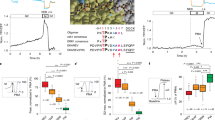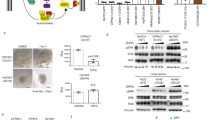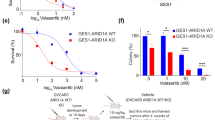Abstract
Cancer cells harboring oncogenic BRaf mutants, but not oncogenic KRas mutants, are sensitive to MEK inhibitors (MEKi). The mechanism underlying the intrinsic resistance to MEKi in KRas-mutant cells is under intensive investigation. Here, we pursued this mechanism by live imaging of extracellular signal-regulated kinases (ERK) and mammalian target of rapamycin complex 1 (mTORC1) activities in oncogenic KRas or BRaf-mutant cancer cells. We established eight cancer cell lines expressing Förster resonance energy transfer (FRET) biosensors for ERK activity and S6K activity, which was used as a surrogate marker for mTORC1 activity. Under increasing concentrations of MEKi, ERK activity correlated linearly with the cell growth rate in BRaf-mutant cancer cells, but not KRas-mutant cancer cells. The administration of PI3K inhibitors resulted in a linear correlation between ERK activity and cell growth rate in KRas-mutant cancer cells. Intriguingly, mTORC1 activity was correlated linearly with the cell growth rate in both BRaf-mutant cancer cells and KRas-mutant cancer cells. These observations suggested that mTORC1 activity had a pivotal role in cell growth and that the mTORC1 activity was maintained primarily by the ERK pathway in BRaf-mutant cancer cells and by both the ERK and PI3K pathways in KRas-mutant cancer cells. FRET imaging revealed that MEKi inhibited mTORC1 activity with slow kinetics, implying transcriptional control of mTORC1 activity by ERK. In agreement with this observation, MEKi induced the expression of negative regulators of mTORC1, including TSC1, TSC2 and Deptor, which occurred more significantly in BRaf-mutant cells than in KRas-mutant cells. These findings suggested that the suppression of mTORC1 activity and induction of negative regulators of mTORC1 in cancer cells treated for at least 1 day could be used as surrogate markers for the MEKi sensitivity of cancer cells.
This is a preview of subscription content, access via your institution
Access options
Subscribe to this journal
Receive 50 print issues and online access
$259.00 per year
only $5.18 per issue
Buy this article
- Purchase on Springer Link
- Instant access to full article PDF
Prices may be subject to local taxes which are calculated during checkout






Similar content being viewed by others
References
Nishida E, Gotoh Y . The MAP kinase cascade is essential for diverse signal transduction pathways. Trends Biochem Sci 1993; 18: 128–131.
Pylayeva-Gupta Y, Grabocka E, Bar-Sagi D . RAS oncogenes: weaving a tumorigenic web. Nat Rev Cancer 2011; 11: 761–774.
Weinstein IB . Cancer. Addiction to oncogenes—the Achilles heal of cancer. Science 2002; 297: 63–64.
Sharma SV, Settleman J . Oncogene addiction: setting the stage for molecularly targeted cancer therapy. Genes Dev 2007; 21: 3214–3231.
Sharma SV, Bell DW, Settleman J, Haber DA . Epidermal growth factor receptor mutations in lung cancer. Nat Rev Cancer 2007; 7: 169–181.
Neuzillet C, Tijeras-Raballand A, de Mestier L, Cros J, Faivre S, Raymond E . MEK in cancer and cancer therapy. Pharmacol Ther 2014; 141: 160–171.
Solit DB, Garraway LA, Pratilas CA, Sawai A, Getz G, Basso A et al. BRAF mutation predicts sensitivity to MEK inhibition. Nature 2006; 439: 358–362.
Singh A, Greninger P, Rhodes D, Koopman L, Violette S, Bardeesy N et al. A gene expression signature associated with ‘K-Ras addiction’ reveals regulators of EMT and tumor cell survival. Cancer Cell 2009; 15: 489–500.
Rebucci M, Michiels C . Molecular aspects of cancer cell resistance to chemotherapy. Biochem Pharmacol 2013; 85: 1219–1226.
Sos ML, Fischer S, Ullrich R, Peifer M, Heuckmann JM, Koker M et al. Identifying genotype-dependent efficacy of single and combined PI3K- and MAPK-pathway inhibition in cancer. Proc Natl Acad Sci USA 2009; 106: 18351–18356.
Klinger B, Sieber A, Fritsche-Guenther R, Witzel F, Berry L, Schumacher D et al. Network quantification of EGFR signaling unveils potential for targeted combination therapy. Mol Syst Biol 2013; 9: 673.
Prahallad A, Sun C, Huang S, Di Nicolantonio F, Salazar R, Zecchin D et al. Unresponsiveness of colon cancer to BRAF(V600E) inhibition through feedback activation of EGFR. Nature 2012; 483: 100–103.
Hatzivassiliou G, Haling JR, Chen H, Song K, Price S, Heald R et al. Mechanism of MEK inhibition determines efficacy in mutant KRAS- versus BRAF-driven cancers. Nature 2013; 501: 232–236.
Pratilas CA, Taylor BS, Ye Q, Viale A, Sander C, Solit DB et al. (V600E)BRAF is associated with disabled feedback inhibition of RAF-MEK signaling and elevated transcriptional output of the pathway. Proc Natl Acad Sci USA 2009; 106: 4519–4524.
Mirzoeva OK, Das D, Heiser LM, Bhattacharya S, Siwak D, Gendelman R et al. Basal subtype and MAPK/ERK kinase (MEK)-phosphoinositide 3-kinase feedback signaling determine susceptibility of breast cancer cells to MEK inhibition. Cancer Res 2009; 69: 565–572.
Engelman JA, Chen L, Tan X, Crosby K, Guimaraes AR, Upadhyay R et al. Effective use of PI3K and MEK inhibitors to treat mutant Kras G12D and PIK3CA H1047R murine lung cancers. Nat Med 2008; 14: 1351–1356.
Bean GR, Ganesan YT, Dong Y, Takeda S, Liu H, Chan PM et al. PUMA and BIM are required for oncogene inactivation-induced apoptosis. Sci Signal 2013. 6–ra20.
LoRusso P, Shapiro G, Pandya SS, Kwak EL, Jones C, Belvin M et al. A first-in-human phase Ib study to evaluate the MEK inhibitor GDC-0973, combined with the pan-PI3K inhibitor GDC-0941, in patients with advanced solid tumors. J Clin Oncol 2012. 30.
Speranza G, Kinders RJ, Khin S, MK Weil, Do KT, Horneffer Y et al. Pharmacodynamic biomarker-driven trial of MK-2206, an AKT inhibitor, with AZD6244 (selumetinib), a MEK inhibitor, in patients with advanced colorectal carcinoma (CRC). J Clin Oncol 2012. 30.
Komatsu N, Aoki K, Yamada M, Yukinaga H, Fujita Y, Kamioka Y et al. Development of an optimized backbone of FRET biosensors for kinases and GTPases. Mol Biol Cell 2011; 22: 4647–4656.
Friday BB, Yu C, Dy GK, Smith PD, Wang L, Thibodeau SN et al. BRAF V600E disrupts AZD6244-induced abrogation of negative feedback pathways between extracellular signal-regulated kinase and Raf proteins. Cancer Res 2008; 68: 6145–6153.
LoRusso PM, Krishnamurthi SS, Rinehart JJ, Nabell LM, Malburg L, Chapman PB et al. Phase I pharmacokinetic and pharmacodynamic study of the oral MAPK/ERK kinase inhibitor PD-0325901 in patients with advanced cancers. Clin Cancer Res 2010; 16: 1924–1937.
Thoreen CC, Kang SA, Chang JW, Liu Q, Zhang J, Gao Y et al. An ATP-competitive mammalian target of rapamycin inhibitor reveals rapamycin-resistant functions of mTORC1. J Biol Chem 2009; 284: 8023–8032.
She QB, Halilovic E, Ye Q, Zhen W, Shirasawa S, Sasazuki T et al. 4E-BP1 is a key effector of the oncogenic activation of the AKT and ERK signaling pathways that integrates their function in tumors. Cancer Cell 2010; 18: 39–51.
Rodriguez-Viciana P, Warne PH, Vanhaesebroeck B, Waterfield MD, Downward J . Activation of phosphoinositide 3-kinase by interaction with Ras and by point mutation. EMBO J 1996; 15: 2442–2451.
Mendoza MC, Er EE, Blenis J . The Ras-ERK and PI3K-mTOR pathways: cross-talk and compensation. Trends Biochem Sci 2011; 36: 320–328.
Roux PP, Ballif BA, Anjum R, Gygi SP, Blenis J . Tumor-promoting phorbol esters and activated Ras inactivate the tuberous sclerosis tumor suppressor complex via p90 ribosomal S6 kinase. Proc Natl Acad Sci USA 2004; 101: 13489–13494.
Carriere A, Romeo Y, Acosta-Jaquez HA, Moreau J, Bonneil E, Thibault P et al. ERK1/2 phosphorylate Raptor to promote Ras-dependent activation of mTOR complex 1 (mTORC1). J Biol Chem 2011; 286: 567–577.
Corcoran RB, Rothenberg SM, Hata AN, Faber AC, Piris A, Nazarian RM et al. TORC1 suppression predicts responsiveness to RAF and MEK inhibition in BRAF-mutant melanoma. Sci Transl Med 2013; 5 196ra198.
Yusa K, Rad R, Takeda J, Bradley A . Generation of transgene-free induced pluripotent mouse stem cells by the piggyBac transposon. Nat Methods 2009; 6: 363–369.
Kawakami K, Noda T . Transposition of the Tol2 element, an Ac-like element from the Japanese medaka fish Oryzias latipes, in mouse embryonic stem cells. Genetics 2004; 166: 895–899.
Miyoshi H, Blomer U, Takahashi M, Gage FH, Verma IM . Development of a self-inactivating lentivirus vector. J Virol 1998; 72: 8150–8157.
Akagi T, Sasai K, Hanafusa H . Refractory nature of normal human diploid fibroblasts with respect to oncogene-mediated transformation. Proc Natl Acad Sci USA 2003; 100: 13567–13572.
Kim DH, Sarbassov DD, Ali SM, King JE, Latek RR, Erdjument-Bromage H et al. mTOR interacts with raptor to form a nutrient-sensitive complex that signals to the cell growth machinery. Cell 2002; 110: 163–175.
Aoki K, Matsuda M . Visualization of small GTPase activity with fluorescence resonance energy transfer-based biosensors. Nat Protoc 2009; 4: 1623–1631.
Otsu N . A threshold selection method from gray-level histograms. IEEE Trans Syst Man Cybern 1979; 9: 62–66.
Fujita Y, Komatsu N, Matsuda M, Aoki K . Fluorescence resonance energy transfer based quantitative analysis of feedforward and feedback loops in epidermal growth factor receptor signaling and the sensitivity to molecular targeting drugs. FEBS J 2014; 281: 3177–3192.
Corcoran RB, Dias-Santagata D, Bergethon K, Iafrate AJ, Settleman J, Engelman JA . BRAF gene amplification can promote acquired resistance to MEK inhibitors in cancer cells harboring the BRAF V600E mutation. Sci Signal 2010. 3–ra84.
Aoki K, Kumagai Y, Sakurai A, Komatsu N, Fujita Y, Shionyu C et al. Stochastic ERK activation induced by noise and cell-to-cell propagation regulates cell density-dependent proliferation. Mol Cell 2013; 52: 529–540.
Mortazavi A, Williams BA, McCue K, Schaeffer L, Wold B . Mapping and quantifying mammalian transcriptomes by RNA-Seq. Nat Methods 2008; 5: 621–628.
Acknowledgements
We are grateful to the members of the Matsuda Laboratory for their helpful input. Y Inaoka, K Hirano, A Katsumata, N Nishimoto, N Nonaka and A Kawagishi are also to be thanked for their technical assistance. KA and MM were supported by the Research Program of Innovative Cell Biology by Innovative Technology (the ‘Cell Innovation’ Program) and Platform for Dynamic Approaches to Living System from the Ministry of Education, Culture, Sports and Science, Japan. KA was supported by a Grant-in-Aid for Young Scientists (B) (23701052) and a Grant-in-Aid for Scientific Research (B). NK and YF were supported by a Grant-in-Aid for JSPS Fellows.
Author information
Authors and Affiliations
Corresponding author
Ethics declarations
Competing interests
The authors declare no conflict of interest.
Additional information
Supplementary Information accompanies this paper on the Oncogene website
Supplementary information
Rights and permissions
About this article
Cite this article
Komatsu, N., Fujita, Y., Matsuda, M. et al. mTORC1 upregulation via ERK-dependent gene expression change confers intrinsic resistance to MEK inhibitors in oncogenic KRas-mutant cancer cells. Oncogene 34, 5607–5616 (2015). https://doi.org/10.1038/onc.2015.16
Received:
Revised:
Accepted:
Published:
Issue Date:
DOI: https://doi.org/10.1038/onc.2015.16
This article is cited by
-
A small natural molecule CADPE kills residual colorectal cancer cells by inhibiting key transcription factors and translation initiation factors
Cell Death & Disease (2020)
-
Rap2B knockdown suppresses malignant progression of hepatocellular carcinoma by inactivating the PTEN/PI3K/Akt and ERK1/2 pathways
Molecular and Cellular Biochemistry (2020)
-
A platform of BRET-FRET hybrid biosensors for optogenetics, chemical screening, and in vivo imaging
Scientific Reports (2018)
-
Transducin (β)-like 1 X-linked receptor 1 promotes gastric cancer progression via the ERK1/2 pathway
Oncogene (2017)
-
Pigment epithelium-derived factor promotes tumor metastasis through an interaction with laminin receptor in hepatocellular carcinomas
Cell Death & Disease (2017)



